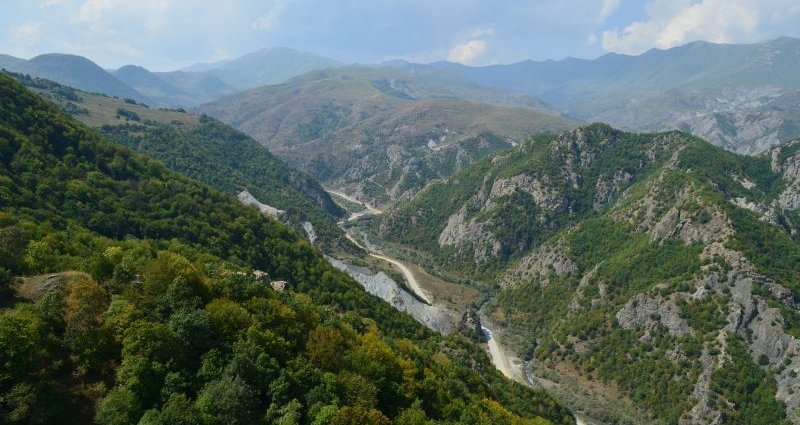Photo of the mountains of Nagorno-Karabakh. Wikipedia, photo by Sonashen, used under licence CC BY-SA 3.0
On September 27, the two states of Azerbaijan and Armenia, located in the South Caucasus, reignited an armed conflict causing military and civilians deaths on all sides. The main reason for the conflict is the control over a territory enclave called Nagorno-Karabakh in English, which is under international law part of Azerbaijan but has been under the control of self-proclaimed ethnic Armenian authorities since 1994.
The enclave at the center of the conflict that has remained unsolved for over three decades is a mountainous area that for centuries had been inhabited by a mix of populations: Christian Armenians and Shia Azerbaijanis for the most part, as well as other groups such as Russians, Kurds, and Greeks.
As in all territories inhabited by different nations using various languages, in this case, Azerbaijanis speaking a Turkic language, Azerbaijani, and Armenians speaking an Indo-European language, Armenian, geographic names have more than one name. Besides, the area came under the political control of various colonial Empires that added their language in the denomination of entities, in this case, this includes Persian, Turkish, and Russian.
The name mostly used in English is spelled Nagorno-Karabakh, which represents a mix of Russian, Turkic, and Persian terms. The first part, ‘Nagorno-’ or ‘Нагорно-‘ in Russian means literally ‘mountainous’, in a reference to the geography of the territory. Karabakh is the English rendering of two Turkic words, ‘kara’ which means black, and bağ, which means garden, but is itself a word of Persian origin widely used in all Turkic languages.
The term Nagorno-Karabakh comes from a Soviet administrative name, the Nagorno-Karabakh Autonomous Region, in Russian Нагорно-Карабахская автономная область that was created in 1923. This administrative entity covered part of what was also called in Russian, Mountainous Karabakh, Нагорный Карабах.
In Azerbaijani, the most common term used to describe the territory is spelled ‘Qarabağ’. In English, two terms are used to describe the population and the language: Azerbaijani and Azeri, but Azerbaijani is prefered as more official and respectful.
In Armenian, there are two terms referring to the territory. One is Ղարաբաղ, which is read Gharabagh, and is a reference to the same historical name of the territory used in Azerbaijani. The other term used is Արցախ, usually rendered in English as Artsakh, which is being promoted by the self-proclaimed authorities de facto in control of the territory politically and militarily, under the name of The Republic of Artsakh. The Republic of Artsakh has been recognized under this name by three other unrecognized territories, Transnistria, South Ossetia and Abkhazia. Armenia has not officially recognized it but provides political, economic, and military support to the Artsakh authorities, and has stated it would recognize it in case of further escalation.
The duality of names also applies to the capital city of the territory that is called Ստեփանակերտ in Armenian, rendered in English as Stepanakert. This name was adopted in 1923 by Soviet authorities to honor an Armenian Bolshevik hero, Stepan Shaumian. In Azerbaijani, this city is known as Xankəndi, usually spelled Khankendi in English.











